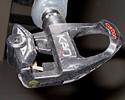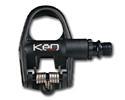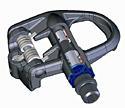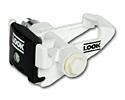
Recently on Cyclingnews.com |
Tech review - December 22, 2004
Look Keo pedals
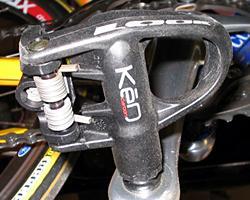
|
With Look pedals remaining virtually unchanged ever since they unveiled the first clipless pedal back in 1984, one would have thought that may be the case for another 20 years more. The release of the new Keo has changed all that; Jonathan Devich applauds the move.
The Keo pedal is based around an injection-molded carbon fiber body with either a chromoly or titanium axle. Claimed weights are 115g for the steel and just 95g for titanium, per pedal - but an extra US$180 for 40 gram weight saving, that's mind-buggeringly expensive. Both versions offer tension adjustment for easier or harder release from the pedal, while three sets of bearings keep the Keo spinning smoothly.
On the inner side of the pedal, towards the crank arm, are two ball bearings, designed for durability and load support. Towards the middle of the axle, a separate roller bearing supports the weight of the rider. All of this can be easily disassembled for maintenance with a single wrench.
Complementing the Keo is the newly-designed cleat. Although smaller than previous cleats, the new shape actually provides more surface contact with the pedal. According to Look, this new cleat provides an area of 259 square millimeters, which, according to them, tops other leading brands. Interesting parts of the cleat are the white Teflon material sections that make up the front and rear contact areas. This new design allows for a much smoother entry, float and release from the pedal. Of course, the float is available on the signature red cleat, while the black cleats are the standard fixed version. Both versions of the cleat also include a set of four wear indicators that alert you if one's taken too many visits to the coffee shop.
Look has also introduced what I like to refer to as the "Adjustment Memory" nub. This little nub screws into the bottom of your shoe with the cleat being screwed down on top of it, so that when it is time to replace your cleats, the new ones will return to the exact same position as the old. Look says that the extra screw hole for the nub will become standard on several manufacturers' shoes this year with others to follow.
Another item to keep in mind when setting up the Keo is that the distance between the spindle and sole of your shoe is, according to Look, only 15.7mm. This height is significantly less than other Look pedals as well as a number of other brands, and should be taken into consideration in reference to your seat height. When I installed the new pedals, I also installed a new saddle that was taller than my old one, so in the end I had to lower my seat only a couple of millimeters to maintain the correct height.
The first thing I noticed about the Keo when clicking into it was how the cleat interacts with the pedal. Placement of the Teflon on the toe and heel section of the cleat made for an extremely smooth feeling of float. I prefer the red cleats because of the nine degrees of float, and left the tension on the factory setting.
Once on the road, the pedal felt like a pedal should, unnoticeable. My personal opinion is that a pedal is not something that you should have to notice when riding. It should provide you with the performance needed while giving you the comfort and reliability that is absolutely necessary. All of this should be achieved without notice and without having to continually go back and fiddle with adjustments. This is exactly how the Look Keo performed for me. Once I had the cleat positioned properly, seat height set, and was satisfied with the tension, that was it. With the low profile of the pedal, your foot feels like it is attached directly to the spindle and the new cleat materials provide smooth float for comfort and easy release from the pedal.
I applaud Look for their 20 years of pedal technology and congratulate them on the breakthrough of the Keo. This pedal proves that there can always be improvement on a classic design.
Recommended retail price: US$ 219.99 (Chromoly), US$ 399.99 (Titanium)
Pros: New cleat design provides more surface contact with pedal and allows
for smoother entry, float and release; "Adjustment Memory" nub; distance between
the spindle and sole of shoe reduced to 15.7mm; no further adjustment once properly
set up
Cons: None
More info: www.lookcycle.com;
US importer: www.veltecsports.com
Cyclingnews Rating: ![]()

